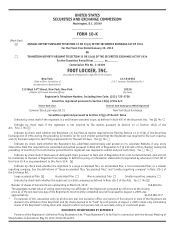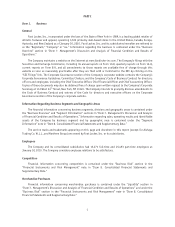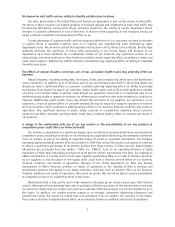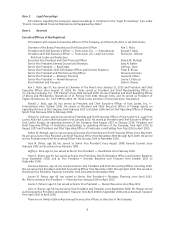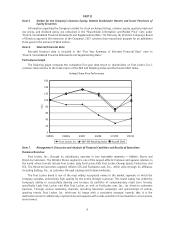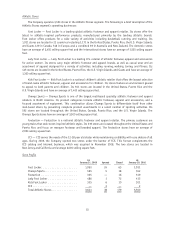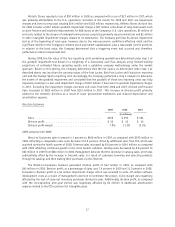Foot Locker 2009 Annual Report Download - page 25
Download and view the complete annual report
Please find page 25 of the 2009 Foot Locker annual report below. You can navigate through the pages in the report by either clicking on the pages listed below, or by using the keyword search tool below to find specific information within the annual report.Unauthorized disclosure of sensitive or confidential customer information, whether through a breach of the
Company’s computer systems or otherwise, could severely harm our business.
As part of the Company’s normal course of business, it collects, processes, and retains sensitive and
confidential customer information. Despite the security measures the Company has in place, its facilities and
systems may be vulnerable to security breaches, acts of vandalism, computer viruses, misplaced or lost data,
programming and/or human error, or other similar events. Any security breach involving the misappropriation,
loss or other unauthorized disclosure of confidential information by the Company could severely damage its
reputation, expose it to the risks of litigation and liability, disrupt its operations and harm its business.
Our reliance on key management, store and field associates.
Future performance will depend upon our ability to attract, retain, and motivate our executive and senior
management team, as well as store personnel and field management. Our success depends to a significant extent
both upon the continued services of our current executive and senior management team, as well as our ability to
attract, hire, motivate, and retain additional qualified management in the future. Competition for key executives
in the retail industry is intense, and our operations could be adversely affected if we cannot attract and retain
qualified associates. Many of the store and field associates are in entry level or part-time positions with
historically high rates of turnover. Our ability to meet our labor needs while controlling costs is subject to
external factors such as unemployment levels, prevailing wage rates, minimum wage legislation, and changing
demographics. If we are unable to attract and retain quality associates, our ability to meet our growth goals or to
sustain expected levels of profitability may be compromised. In addition, a large number of our retail employees
are paid the prevailing minimum wage, which if increased would negatively affect our profitability.
We face risks arising from possible union legislation in the United States.
There is a possibility that the proposed Employee Free Choice Act, (‘‘EFCA’’) or similar legislation or
regulations may be enacted. EFCA, also referred to as the ‘‘card check’’ bill, if passed in its current form could
significantly change the nature of labor relations in the United States, specifically, how union elections and
contract negotiations are conducted. It would be easier for unions to win elections and we could face
arbitrator-imposed labor scheduling, costs and standards. Therefore, EFCA could impose more labor relations
requirements and union activity on our business, thereby potentially increasing our costs, and could have a
material adverse effect on our overall competitive position.
Failure to fully comply with Section 404 of the Sarbanes-Oxley Act of 2002 could negatively affect our
business, the price of our common stock and market confidence in our reported financial information.
We must continue to document, test, monitor, and enhance our internal controls over financial reporting in
order to satisfy all of the requirements of Section 404 of the Sarbanes-Oxley Act of 2002. We cannot be assured
that our disclosure controls and procedures and our internal controls over financial reporting required under
Section 404 of the Sarbanes-Oxley Act will prove to be completely adequate in the future. Failure to fully comply
with Section 404 of the Sarbanes-Oxley Act of 2002 could negatively affect our business, the price of our common
stock and market confidence in our reported financial information.
Item 1B. Unresolved Staff Comments
None.
Item 2. Properties
The properties of the Company and its consolidated subsidiaries consist of land, leased and owned stores,
and administrative and distribution facilities. Gross square footage and total selling area for the Athletic Stores
segment at the end of 2009 were approximately 12.96 and 7.74 million square feet, respectively. These
properties, which are primarily leased, are located in the United States, Canada, various European countries,
Australia, and New Zealand.
The Company currently operates four distribution centers, of which two are owned and two are leased,
occupying an aggregate of 2.46 million square feet. Three of the four distribution centers are located in the
United States and one is in the Netherlands.
7


